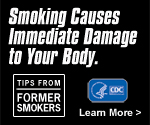Low-Yield Cigarettes
Overview
After the landmark 1964 Surgeon General's Report on the health consequences of smoking, cigarette manufacturers began heavily marketing cigarettes labeled "light," "low," and "mild" (or similar descriptors).1 Cigarettes with "light/low/mild" labels delivered less tar or nicotine in standardized machine measurements.1,2 They were often referred to as "potentially reduced-exposure products," and advertisements implied that they were safer than regular or "full-flavor" cigarettes.1,2
However, due to passage of the Family Smoking Prevention and Tobacco Control Act, manufacturers are now prohibited from manufacturing for sale or distribution any tobacco products for which the label, labeling, or advertising contains the descriptors "light," "low," or "mild" or any similar descriptors.3
There is no strong scientific evidence that low-yield cigarettes are less harmful than regular cigarettes.1 Smoking cessation is the only way smokers can avoid the health risks of smoking (see CDC's Smoking Cessation fact sheet for more information).4
Cigarette Design
Low-yield cigarettes were defined by measuring tar on standardized smoking machines.1
- Cigarette brands that yield approximately 1–6 mg of tar were historically called "ultra light."
- Those with approximately 6–15 mg of tar were called "light."
- Brands yielding more than 15 mg of tar were called "regular" or "full flavor."
The following cigarette design changes over the past decades affected the tar and nicotine measurements:1,2,4
- Addition of different size and density filters
- Ventilation holes in the cigarettes to bring in air and dilute the smoke measured
- Chemical additives in the paper and/or tobacco
- Tobacco (i.e., using different types, blends, and curing methods)
Changes in cigarette design have not made cigarettes safe.1,4
- No strong scientific evidence exists indicating that changes in cigarette design have resulted in a decrease in the diseases caused by smoking cigarettes.
Compensatory Smoking
Most smokers are addicted to nicotine, and, consequently, compensate when smoking low-yield cigarettes in order to take in more nicotine than estimated by a smoking machine.1,4,5,6
- Many smokers block the ventilation holes, thus inhaling more tar and nicotine than measured by machines.
- Many smokers inhale longer, harder, and more frequently when smoking low-yield cigarettes to get more nicotine.
- Smokers may get as much or more tar and nicotine from cigarettes with low-yield ratings as from regular cigarettes because of the ways they compensate when smoking them.
Smokers Who Use Low-Yield Cigarettes
- Use of low-tar products increases dramatically as age, education level, and income level increase.1
- Use of low-yield cigarettes is higher among women than men.1
- Many smokers consider smoking low-yield cigarettes, menthol cigarettes, or additive-free cigarettes to be safer than smoking regular cigarettes, even though no strong scientific evidence exists to substantiate these beliefs.1,2,4
- Many smokers may have switched to low-yield brands instead of quitting; smokers may be misled by the implied promise of reduced toxicity underlying the marketing of such brands.1,4,5
Health Risks of Smoking
- Existing research does not support recommending that smokers switch to low-yield cigarettes.1
- No strong scientific evidence exists indicating that changes in cigarette design have resulted in a decrease in the diseases caused by cigarettes.1,7
References
- National Cancer Institute.
Risks Associated with Smoking Cigarettes with Low Machine-Measured Yields of Tar and Nicotine. Smoking and Tobacco Control Monograph 13
 . (PDF–2.9 MB) Bethesda: U.S. Department of Health and Human Services, National Institutes of Health, National Cancer Institute, 2001 [accessed 2012 May 23].
. (PDF–2.9 MB) Bethesda: U.S. Department of Health and Human Services, National Institutes of Health, National Cancer Institute, 2001 [accessed 2012 May 23]. - Institute of Medicine.
Clearing the Smoke: Assessing the Science Base for Tobacco Harm Prevention
 . Washington: National Academy Press, 2001 [accessed 2012 May 23].
. Washington: National Academy Press, 2001 [accessed 2012 May 23]. - U.S. Food and Drug Administration.
Guidance for Industry and FDA Staff: Use of "Light," "Mild," "Low," or Similar Descriptors in the Label, Labeling, or Advertising of Tobacco Products
 . Rockville (MD): U.S. Food and Drug Administration, Center for Tobacco Products, 2010 [accessed 2012 May 23].
. Rockville (MD): U.S. Food and Drug Administration, Center for Tobacco Products, 2010 [accessed 2012 May 23]. - Campaign for Tobacco-Free Kids. Light and Low Tar Fact Sheets
 . Washington: Campaign for Tobacco-Free Kids, 2010 [accessed 2012 May 23].
. Washington: Campaign for Tobacco-Free Kids, 2010 [accessed 2012 May 23]. - U.S. Department of Health and Human Services.
Reducing Tobacco Use: A Report of the Surgeon General
 .
Atlanta: U.S. Department of Health and Human Services, CDC, National Center for Chronic Disease Prevention and Health Promotion, Office on Smoking and Health, 2000 [accessed 2012 May 23].
.
Atlanta: U.S. Department of Health and Human Services, CDC, National Center for Chronic Disease Prevention and Health Promotion, Office on Smoking and Health, 2000 [accessed 2012 May 23]. - Public Health Law Center.
Light/Low-Yield Cigarettes
 . St. Paul (MN): Public Health Law Center, 2010 [accessed 2012 May 23].
. St. Paul (MN): Public Health Law Center, 2010 [accessed 2012 May 23]. - U.S. Department of Health and Human Services.
The Health Consequences of Smoking: A Report of the Surgeon General
 .
Atlanta: U.S. Department of Health and Human Services, Centers for Disease Control and Prevention, National Center for Chronic Disease Prevention and Health Promotion, Office on Smoking and Health, 2004 [accessed 2012 May 23].
.
Atlanta: U.S. Department of Health and Human Services, Centers for Disease Control and Prevention, National Center for Chronic Disease Prevention and Health Promotion, Office on Smoking and Health, 2004 [accessed 2012 May 23].
For Further Information
Centers for Disease Control and Prevention
National Center for Chronic Disease Prevention and Health Promotion
Office on Smoking and Health
E-mail: tobaccoinfo@cdc.gov
Phone: 1-800-CDC-INFO
Media Inquiries: Contact CDC's Office on Smoking and Health press line at 770-488-5493.
Links to non-federal organizations are provided solely as a service to our users. These links do not constitute an endorsement of these organizations or their programs by CDC or the federal government, and none should be inferred. CDC is not responsible for the content of the individual organization Web pages found at these links.
File Formats: All viewers, players, and plug-ins used on this site can be downloaded from the file formats page. (For example: Adobe Acrobat Reader for pdf files, Windows Media Player for audio and video files, PowerPoint Viewer for presentation slides, etc.)
Contact Us:
- CDC/Office on Smoking and Health
4770 Buford Highway
MS K-50
Atlanta, Georgia 30341-3717 - 800-CDC-INFO
(800-232-4636)
TTY: (888) 232-6348
8am–8pm ET
Monday–Friday
Closed Holidays - tobaccoinfo@cdc.gov





